Toyota AE86
| Toyota Corolla Levin/ Sprinter Trueno (AE86) | |
|---|---|
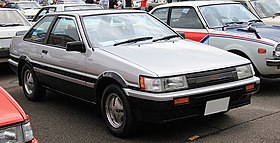 1983–1985 Toyota Corolla Levin GT-APEX coupé | |
| Overview | |
| Manufacturer | Toyota |
| Production | May 1983[1]–1987 |
| Model years | 1984–1987 |
| Assembly | Toyota City, Japan (Takaoka plant)[2] |
| Body and chassis | |
| Class | Sport compact Hot hatch |
| Body style | 2-door coupé, 3-door liftback |
| Layout | Front-engine, rear-wheel drive |
| Platform | E70[3][4] |
| Related | Toyota AE85 Toyota Corolla (E70) Toyota Sprinter (E70) Daihatsu Charmant |
| Powertrain | |
| Engine | 1.6 L 4A-C I4 SOHC (North America & Australia[5]) 1.6 L 4A-GEU I4 DOHC 1.6 L 4A-GEC I4 DOHC (North America) |
| Transmission | T50 5-speed manual A42DL 4-speed automatic |
| Dimensions | |
| Wheelbase | 2,400 mm (94 in)[2] |
| Length | Corolla Levin: 4,185 mm (165 in) (1983-1985)[6] 4,200 mm (165 in) (1985-1987)[7] Sprinter Trueno: 4,205 mm (166 in) (1983-1985)[2] 4,215 mm (166 in) (1985-1987)[8] |
| Width | 1,625 mm (64 in)[2] |
| Height | 1,335 mm (53 in)[2] |
| Curb weight | 900–1,045 kg (1,984–2,304 lb)[6][10] |
| Chronology | |
| Predecessor | Toyota Corolla Levin/Sprinter Trueno TE71 |
| Successor | Toyota Corolla Levin/Sprinter Trueno AE92 |
The AE86 series of the Toyota Corolla Levin and Toyota Sprinter Trueno are small, front-engine/rear-wheel-drive models within the front-engine/front-wheel-drive fifth generation Corolla (E80) range — marketed by Toyota from 1983 to 1987 in coupé and liftback configurations.
Lending themselves to racing, the cars were light, affordable, easily modifiable and combined a five-speed manual transmission, optional limited slip differential, MacPherson strut front suspension, high revving (7800 rpm), twin-cam engine with oil cooler (e.g., in the US), near 50/50 front/rear weight balance, and importantly, a front-engine/rear-drive layout — at a time when this configuration was waning industry-wide.
Widely popular for Showroom Stock, Group A, and Group N, Rally and Club racing, the cars' inherent qualities also earned the AE86 an early and enduring international prominence in the motorsport discipline of drifting. The AE86 was featured centrally in the popular, long-running Japanese manga and anime series titled Initial D (1995–2013) — as the main character's drift and tofu delivery car. In 2015, Road & Track called the AE86 "a cult icon, inextricably interwoven with the earliest days of drifting."[11]
The AE86 would go on to inspire the Toyota 86 (2012–present),[12] a 2+2 sports car jointly developed by Toyota and Subaru, manufactured by Subaru — and marketed also as the Toyota GT86, Toyota FT86, Scion FR-S and Subaru BRZ.
Name[]
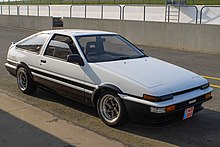
The nameplate Trueno derives from the Spanish word for thunder,[13] and Levin derives from the Middle English for lightning.[14] In Japan, the Sprinter Trueno was exclusive to Toyota Japan dealerships called Toyota Auto Store, while the Corolla Levin was exclusive to Toyota Corolla Store.
The name AE86 derives from Toyota's internal code during the car's development, designating the 1600 cc RWD model from the fifth generation of the Corolla. In Toyota's code language, the "A" designates the car's engine (4A series), "E" designates Corolla, "8" designates fifth generation (E80 series) and "6" designates the variant within this generation.
The AE86 is also called the "Hachi-Roku (ハチロク)", Japanese for "eight-six". Similarly the AE85 was commonly called "Hachi-Go (ハチゴー)", meaning "eight-five". Bracketing a minor external facelift, models marketed between 1983–1985 are called "zenki" (前期, lit. early period), and those marketed from 1986–1987 are called "kouki" (後期, lit. latter period).[15][16]
In 1986, Toyota marketed a limited edition model of the AE86 as the "Black Limited" model.[17]
Engine/technical[]
The AE86 was available with a fuel injected naturally aspirated 4A-GE Inline-four engine DOHC 4 valves per cylinder 1,587 cc (1.6 L; 96.8 cu in) in Japan and Europe, which was also used in the first-generation MR2 G Limited (AW11), Celica 1600GT-R (AA63) and Carina 1600GT (AA63) (Japan only) with a compression ratio of 9.4:1, had a maximum SAE gross power output of 130 PS (128 hp; 96 kW) at 6,600 rpm and 110 lb⋅ft (149 N⋅m) at 5,200 rpm of torque in standard form,[18] though it was later down-rated to 120 PS (118 hp; 88 kW) and 105 lb⋅ft (142 N⋅m) in net output.[16] The AE86 came with a 5-speed manual gearbox, and later came with the option of an automatic. The 4A-GE engines used in the AE86 and AW11 were equipped with Toyota Variable Intake System (T-VIS). The AE86 had an optional LSD.[16]
In North America, a modified 4A-GEC engine was used to comply with California emissions regulations. Power was rated at 112 hp (114 PS; 84 kW) and 136 N⋅m (100 lb⋅ft) of torque.[16]
The AE86 used ventilated disc brakes. The car was equipped with a MacPherson strut style independent suspension at the front and a four-link live axle with coil springs for the rear as well as stabilizer bars, front and rear.[16]
Higher-spec AE86 models known as the Sport GT-S featured the DOHC 4A-GE, 4 wheel disc brakes, color matched bumpers, front lower bumper surround had a much more sporty and pronounced lip, door panels were moulded, tachometer redline is around 7,500, wrapped steering wheel, seats had leather wrapped tops (front seats are completely different from Sport SR5), optional LSD, and aluminium wheels, chassis code in the VIN is AE88 (for North American market cars).
Lower-spec American AE86 SR5 models used the 1,587 cc (1.6 L) 4A-C SOHC unit, The SR5 rear end was a non LSD with drum brakes. The SR5 model also had a softer suspension, and small styling and interior changes such as seats, gauge cluster, door panels, un-painted front and rear bumpers, and the lower part of the front bumper surround is shorter and flat, and its chassis code in the vin differs as well being AE86 for the SR5 model (for North American market cars).
Models equipped with the 4A-GE engine received a 6.7 in (170 mm) rear differential, while 4A-U, and 4A-C models received a smaller, weaker, 6.38 in (162 mm) rear differential.
The AE86 SR5 (4A-C equipped) had an optional automatic transmission, though the GT-S model (with the 4A-GE DOHC engine) only came with a standard 5-speed manual gearbox.
One of the staff who was behind the car's engineering work was Nobuaki Katayama, who would later head the company's motorsport department and who would become chief engineer of the Altezza project a decade later.[citation needed] He has a photo of an AE86 hung in his office.[19]
Body styles[]

The Levin and Trueno featured fixed-headlights and retractable headlights respectively, with both available as hatchback or coupé. The export model name Corolla applies to both variations. The AE86 (along with the lower spec 1,452 cc (1.5 L; 88.6 cu in) AE85 and 1,587 cc (1.6 L; 96.8 cu in) SR5 versions) was rear wheel drive, built on the rear wheel drive E70 Corolla platform[3][4] (same wheelbase length, interchangeable parts, etc), unlike the front wheel drive E80 models in the same range.
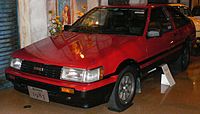
1983–1985 Corolla Levin GTV liftback (Japan)
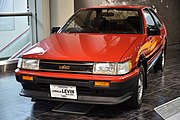
1983–1985 Corolla Levin GT Coupe with alternative optional grill (Japan)
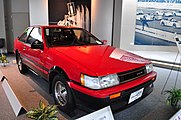
1983–1985 Corolla Levin GT-APEX coupé with alternative optional grill (Japan)

1983–1985 Corolla Levin GT-V liftback (Japan)

1983–1985 Corolla Levin GT coupé (Japan)

Initial D replica of 1983–1985 Sprinter Trueno GT liftback (Japan)
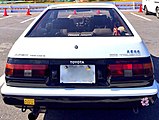
1983–1985 Sprinter Trueno GT-APEX liftback (Japan)

1984–1985 Sprinter Trueno AE85/86 coupé taillights (Japan)
Minor bodywork changes were made in 1985 which resulted in different tail lights, front and rear bumpers, corner and headlight trim lights, and grilles, are the main differences for both AE85/86 Levin and Trueno coupé and liftback models.

1985–1987 Toyota Corolla Levin GT-APEX liftback (Japan)

1985–1987 Toyota Corolla Levin GT-APEX liftback (Japan)

1985–1987 Corolla Levin taillights on the 1985–1987 Corolla Sport SR5 coupé (US)

1985–1987 Sprinter Trueno GT-APEX coupé (Japan)
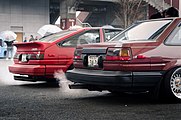
1985–1987 Sprinter Trueno coupé & liftback (Japan)
Models/specifications[]
In Japan, the DOHC 4A-GEU AE86 was offered in GT, GT-APEX and GTV trims as the Corolla Levin or Sprinter Trueno. In North America, the top-spec DOHC 4A-GEC was sold as the Corolla Sport GT-S[20] (with AE86 on the build plate in the engine bay but AE88 in the VIN), with the SOHC 4A-C being sold as the Corolla Sport SR5[20] (with AE86 on the build plate and in the VIN). Both versions were sold with Trueno pop-up headlights and Levin taillights. Euro spec models were sold as the Corolla GT with DOHC engines and fixed Levin-style headlights. Australian models were sold as the Toyota Sprinter, also with fixed Levin headlights and Trueno taillights.[5] The Middle East received the same basic model as the North American market, with pop-up headlights and the regulated 5 mph (8 km/h) bumpers.
The lightest AE86 is the Japanese 2 door GT model which weighs 900 kg (1,984 lb).[6] It has the same exterior as the GTV trim, but with the interior of the AE85 with the exception of the gauges, and is equipped with rear drum brakes.
North American AE86 specifications[]
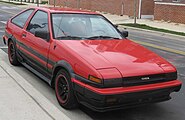
1983–1987 Corolla Sport GT-S liftback (US)

1983–1987 Corolla Sport GT-S coupé (Canada)
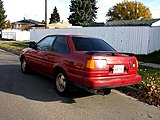
1985–1987 Corolla Sport GT-S coupé (Canada)

1983–1987 Corolla Sport SR5 liftback (US)
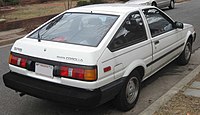
1985–1987 Corolla Sport SR5 liftback (US)
There are three types of Corolla Sport RWD for the US market: DX, SR5, and GT-S, though the DX was generally an internal Toyota designation, as brochures, and advertising do not include the DX designation;[16] it consisted of a lower trim level, lighter duty suspension parts and the like.
- Model Years of production: 1983 to 1987
- Versions: DX, SR5 and GT-S (85+ Only)
- drag coefficient of Cd=0.39
Note that the VIN and the chassis code do not match for all models.
DX & SR5 specifications[]
- First 7 characters of VIN: JT2AE85 (DX) or JT2AE86 (SR5)
- Chassis code: AE86 (which may differ from the VIN)
- Horsepower: 87 bhp (65 kW; 88 PS) @ 4800 rpm
- Torque: 115 N⋅m (85 lb⋅ft) @ 2800 rpm
- Weight: approximately 2,200 to 2,300 lb (998 to 1,043 kg)
- Engine: 4A-C, 1,587 cc (1.6 L; 96.8 cu in)
- Engine type: SOHC 8-valve Inline-4 carbureted
- M/T transmission: T50, 6-bolt flywheel
- A/T transmission: A42DL, 4-speed overdrive w/lockup torque converter, mechanically controlled, with electronically engaged overdrive
- Compression: 9.0:1
- Differential: 6.38 inches (162 mm) open with 4.10:1 ratio, 2-pinion (automatic) (S292) or 3.91:1 ratio, 4-pinion (5-speed) (S314)
- Wheels/tires: 13×5" +33 mm offset rims with 185/70R13 tires
GT-S specifications[]
- First 7 characters of VIN: JT2AE88
- Chassis code: AE86 (which differs from the VIN)
- Horsepower: 112 bhp (84 kW; 114 PS) @ 6600 rpm
- Torque: 132 N⋅m (97 lb⋅ft) @ 4800 rpm
- Weight: approximately 2,200 to 2,300 lb (998 to 1,043 kg)
- Engine: 4A-GE, 1,587 cc (1.6 L; 96.8 cu in)
- Engine type: DOHC 16-valve Inline-4 AFM Multiport Fuel Injection w/T-VIS
- Transmission: T50, 8-bolt flywheel
- Injector size: approx. 180 cc (11 cu in), low impedance
- Compression: 9.4:1
- Differential: 6.7 inches (170 mm) Open (T282) or optional LSD (USA Only) (T283) with 4.30:1 Ratio, 2-pinion
- Wheels/tires: 14×5.5" +27 mm offset rims with 185/60R14 82H tires (195/60R14 85H for 86+ models)
The AE86 in motorsports[]
This article needs additional citations for verification. (July 2018) |

While in production, the AE86 was a popular choice for showroom stock, Group A, and Group N racing, especially in rallying and circuit races. After production ended, many private teams continued to race the AE86, and it remains a popular choice for rallying and club races today.
Part of the continued appeal of the AE86 for motorsports is its rear-drive configuration, not available in most newer lightweight coupes. In Group A touring car races, the car either dominated the lower category where eligible or fought it out with Honda Civics or the later AE92s and AE101s whilst maintaining its competitiveness. In Ireland, where rallying is considered one of the most popular forms of motorsport, as organizing regulations are more relaxed compared to that of other countries, the AE86 was popular when new, and remains so popular that teams will purchase cars from the UK due to local shortages. The AE86 is also popular for rally use in Finland, where the cars can be competitive in the F-Cup competition for naturally aspirated 2WD cars.[citation needed]
The AE86 was entered in the European Touring Car Championship from 1984 to 1988 with a 150 hp (112 kW) 4A-GEU engine.[citation needed] In 1986 it beat the BMW M6, BMW 325i (E30), Rover Vitesse, Volvo 240 Turbo, Merkur XR4Ti, Mazda 929, Holden Commodore (VK), Alfa Romeo 75 (turbo V6), and Mercedes 190E 2.3-16 to win the Manufacturers Championship with 267 points, surpassing the 1986 Drivers Championship Schnitzer Motorsport BMW M6.[21]
In 1986 and 1987 Chris Hodgetts won the British Touring Car Championship (BTCC), beating the V8 Rover SD1's, Ford Sierra Cosworth's and BMW 3 Series (E30) M3's two years running for an overall points victory driving an AE86 for Toyota (GB) PLC and his own race prep team CHMS.[22]
The semi-factory supported Kraft team entered a spaceframe Trueno at the JGTC with a 3S-GTE engine that came from a SW20 MR2 Turbo producing about 300 hp (224 kW) for the JGTC GT300 regulations in 1998. Despite being popular with the racefans, the car had minor success and was abandoned from use halfway through the 2001 season in favor of a newly delivered MR-S.[citation needed]
The rear wheel drive configuration, combined with the AE86's light weight (approximately 2300 lb (950–970 kg) curb weight), balance and relatively powerful (and easy to tune) 4A-GEU engine made it popular among the Japanese hashiriya (street racers in Japanese), many of whom raced in touge (mountain passes in Japanese) where the corners suited the AE86 best, especially on the downhill.[16] Among those who utilized this car was Japanese racing legend Keiichi Tsuchiya also known as the Drift King ("Dori-Kin" in Japanese). Keiichi Tsuchiya helped popularize the sport of drifting, which involves taking a car on a set of controlled slides through corners.[16] The AE86's FR configuration made it well suited to this kind of cornering, and currently the car is a mainstay of drift shows and competitions. Japanese drifters like Katsuhiro Ueo, Toshiki Yoshioka, Yoichi Imamura, Koichi Yamashita, Hiroshi Takahashi, Tetsuya Hibino, and Wataru Hayashi were also involved in making the AE86 famous in the drift scene.[citation needed]
AE86s around the world have been extensively modified for use in professional drifting.[23]
The AE86 was also rallied by several rally drivers across the world.
In popular culture[]

The main character of the anime and manga Initial D, Takumi Fujiwara, uses his father's AE86 Trueno GT-Apex Hatchback for racing and making his tofu deliveries. Takumi's friend, Itsuki Takeuchi, drives an AE85 Levin. Throughout the series, two of Takumi's opponents drive AE86s: Wataru Akiyama a turbocharged AE86 Corolla Levin and Shinji Inui the Notchback coupe version of the AE86 Trueno. The AE86 is also a playable vehicle in the Initial D Arcade Stage series. In The Fast And The Furious, a red Corolla AE86 can be seen in the background waiting in line to enter the Race Wars. The AE86 also made a brief cameo in The Fast and the Furious: Tokyo Drift and Fast and Furious 4. The popularity of Initial D is cited as the main cause of the car's high resale price, which is often referred to as "Takumi tax" or "Tofu tax", after the main character and his tofu delivery occupation.[24]
References[]
- ^ "Toyota Family Tree". toyota-global.com. Retrieved 2014-08-25.
- ^ Jump up to: a b c d e "75 years of Toyota - Sprinter Trueno 5th". www.toyota-global.com. Retrieved 2020-11-26.
- ^ Jump up to: a b Lye, Gerard (2020-11-26). "TAS 2020: Toyota 86 Black Limited Concept and AE86 Sprinter Trueno GT-Apex Black Limited on display". paultan.org. Malaysia. Retrieved 2020-01-17.
- ^ Jump up to: a b Hsu, Dan (2011-06-08). "EVENTS: 2011 Toyotafest Part 06". Japanese Nostalgic Car. US. Retrieved 2020-11-26.
- ^ Jump up to: a b "Australian Toyota Sprinter AE86 brochure 1983-10". Retrieved 2020-11-26.
- ^ Jump up to: a b c "Toyota Corolla Levin AE86 Japanese brochure". www.banpei.net. Retrieved 2020-11-26.
- ^ "75 years of Toyota - Corolla Levin 5th". www.toyota-global.com. Retrieved 2020-11-26.
- ^ "1986 Toyota Sprinter Trueno". japanclassic.ru. Retrieved 2020-11-26.
- ^ Marcus, Frank (2018-05-17). "Feature Flashback: 1984 Toyota Corolla SR5". Motor Trend. Retrieved 2020-11-26.
- ^ "US E80 Corolla catalogue". club4ag.com. Retrieved 2020-11-26.
- ^ Sorokanich, Bob (2015-08-25). "Understanding the Allure of the Toyota AE86". Road & Track Magazine. Retrieved 2018-07-21.
- ^ "Toyota Sports Car Heritage | Toyota 86 Predecessors". Arabia MSN Autos. Retrieved 2012-06-12.[permanent dead link]
- ^ "75 Years of TOYOTA | 5th Sprinter Trueno". Toyota. 2012. Retrieved 2020-06-25.
- ^ "75 Years of TOYOTA | 5th Corolla Levin". Toyota. 2012. Retrieved 2020-06-25.
- ^ Hachiroku.com.au Blog - はちろくブログ Archived 2012-02-11 at the Wayback Machine - AE86: An In-Depth Look at A Legend
- ^ Jump up to: a b c d e f g h Drift Japan » Toyota Corolla AE86 Archived 2007-06-29 at the Wayback Machine - AE86 History and Overview
- ^ "AE86 Trivia: all Sprinter Trueno AE86 Black Limited facts". Banpei.net. The Netherlands. 2013-12-14. Retrieved 2020-06-25.
- ^ "Toyota Sprinter Trueno Coupé GT Apex, 1983 MY AE86 E-AE86-FSMVF specifications". carfolio. Retrieved 2018-06-15.
- ^ "AE86". CAR Magazine. April 1999.
- ^ Jump up to: a b MOOK, M.B. (2016-10-31). トヨタ・カローラ50年とその時代 [Toyota Corolla's 50 years] (in Japanese). Japan. ISBN 978-4866400150.
- ^ "European Touring Car championship - 1986". Touringcarracing.net. Retrieved 2016-03-12.
- ^ "BTCC Champions". British Touring Car Championship. Retrieved 2021-05-04.
- ^ Petrány, Máté (2014-11-21). "Europeans Have To Out-Crazy Japan When It Comes To Drift Cars". Jalopnik. Retrieved 2018-02-01.
- ^ O'Mara, Sean (2013-01-28). "The Enduring Legacy of Initial D and the AE86". Retrieved 2013-02-01.
| Wikimedia Commons has media related to Toyota AE86. |
| show |
|---|
- Toyota vehicles
- Rear-wheel-drive vehicles
- Rally cars
- Sport compact cars
- Hot hatches
- 1980s cars
- Cars introduced in 1983

















